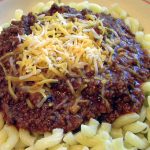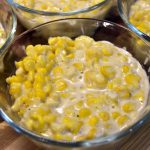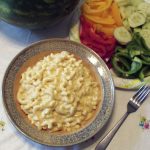A dish of mine that breaks a lot of the supposed rules about pasta, US Marine-Style Chili Mac. The former Marine was happy with it, which is what matters. I’ve been away from this blog for a while now. Eight months, plus-or-minus a few days, off doing other web projects and writings while upgrading my […]
Category: Family Traditions
Recipe: Crock Pot Creamed Corn
One of the most popular recipes on Luna Pier Cook is Mary Jewett’s Kentucky Sweet Corn Pudding. We’ve enjoyed it ourselves for many holiday get-togethers over the couple decades since we first got a copy of it from Mary herself. The number of page views on the recipe have really skyrocketed since I first posted […]
Recipe: Sharron Lee’s Classic Dark Christmas Fruitcake … with Pork Fat
Click on any image for a larger version. Scott Lee is an old friend of mine. Not that he’s actually old … he’s as middle-aged as I am, and slightly older by a few months. But Scott’s been around most of my life. We met in art class in 6th grade, spent time studying magic […]
My Father’s Day 2010 Dinner: Kid-Made Stuffed Burgers & Fruit Salad
My kids have been busting their butts all day long. The day started with a knock at the bedroom door. On the other side was 13-year-old Ryan. In each of his hands was a large mug of Biggby Michigan Cherry coffee, a mug each for Mary and I. He’d brewed it himself and to tell you […]
Father’s Day, A Tribute to Dad
Many of you know my dad passed away late December in 2008 at the tender age of 85. I’ve written before of his signature dish, Eggs In A Frame, and of his despising melted cheese in any form even though I have a photo of him eating pizza. But while I’ve posted a lot more […]
Recipe: Phillips/Chesapeake Bay-style Crab Cakes
The finished crab cake sandwiches. Zack and Chris ate these two. I hadn’t really planned on making crab cakes for Memorial Day. But I’d been looking for these cans of Phillips crab meat for some time and when I found them to be available at Meijer in Toledo last week for $10/can, I went ahead […]
A Simple Roast Beef Dinner: Happy Anniversary Mom & Dad
57 years ago today my parents were married in Flint, Michigan. For as long as I could remember, my mom made a simple yet traditional roast beef dinner in one of those navy blue oval roasting pans about once each month. But she did it the old way. She’d place the roast in the middle […]
Homemade Old-World Lunchmeats in Toledo? Yes, at Kilgus Choice Meats
Homemade Dutch loaf, homemade Kielbasa loaf, and some homemade Krakowska sausage, all from Kilgus Meats. When I got the slices of loaf lunchmeats home, that’s when I realized they were still warm. A variation of this article is also posted on the Toledo Food Examiner pages of Examiner.com. Paul … quit bugging me already … […]


